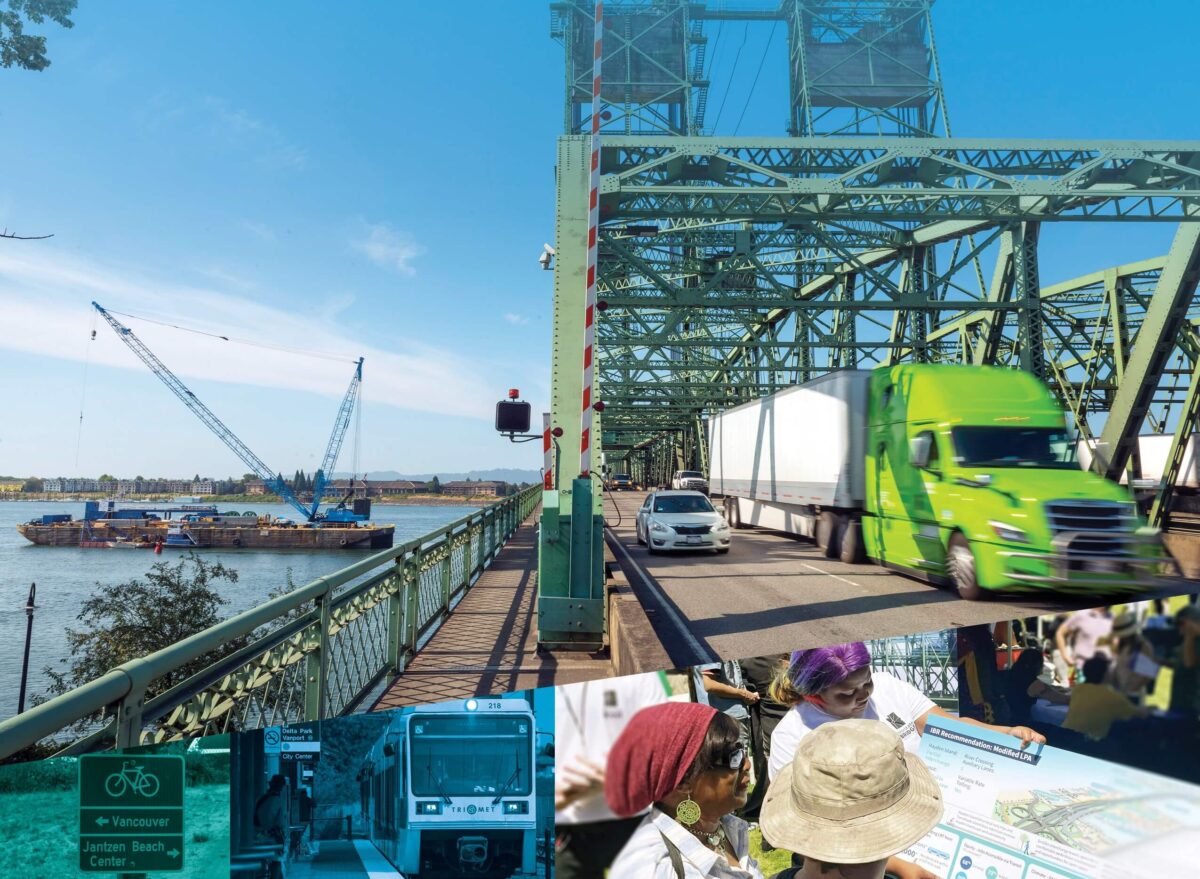The Interstate Bridge Replacement (IBR) Program’s Draft Supplemental Environmental Impact Statement (SEIS) is now available for the public to review. The 60-day public comment period begins Friday, Sept. 20 and runs through Monday, Nov. 18, 2024.
Vview and comment on the Draft SEIS online at www.InterstateBridge.org/DraftSEIS. Community members can also request the opportunity to review a hard copy of the Draft SEIS at the IBR office in downtown Vancouver.
All public comments provided during this time will be recorded and responses to these comments will be included in the Final SEIS, which is anticipated in late 2025.
There are several ways for the public to comment on the Draft SEIS. Written comments on the Draft SEIS can be submitted through the online comment form at www.interstatebridge.org/DraftSEIS, by email to DraftSEIS@interstatebridge.org, or by regular mail to the address below.
IBR Program Draft SEIS, c/o Chris Regan, IBR Program Environmental Manager, 500 Broadway Street, Suite 200 Vancouver, WA 98660
Comments may also be submitted by leaving a voice message on the IBR Program’s comment line at (866) IBR-SEIS (866-427-7347) (toll-free).
Comments can also be submitted orally and in writing at a virtual or public hearing for the Draft SEIS on the following dates and locations:
Tuesday, October 15, 2024: Clark College, Gaiser Hall 150, 1933 Fort Vancouver Way Vancouver, WA 98663 5:30-8:30 PM,
Thursday, October 17, 2024: Portland Expo Center, Exhibit Hall E2 2060 N. Marine Drive Portland, OR 97217 5:30-8:30 PM
Saturday, October 26, 2024 See www.interstatebridge.org for link 12:00-1:30 PM
Wednesday, October 30, 2024: See www.interstatebridge.org for link 6:00-7:30 PM
The Draft SEIS document is easily available and accessible for all community members, as required by federal law. The document meets ADA standards, offers an online search function to make locating specific information easy, and the Executive Summary is translated into multiple languages. Language interpretation and American Sign Language services will be offered at upcoming meetings and when requested to ensure accessibility for all community members.
The Draft SEIS is the comprehensive documentation of the Program’s potential benefits and impacts on transportation, the community and the natural environment in the Program area. It is a federal requirement of the National Environmental Policy Act (NEPA), which is an opportunity and responsibility for the Program to analyze how the proposed investments in our region’s transportation infrastructure might affect topics such as air and water quality, parks and historic sites, ecosystems, greenhouse gas emissions, noise and vibration, travel times for vehicles and public transit within the study area, hours of congestion, economics, land use and property acquisitions, and neighborhoods. It also analyzes the Program’s impacts or benefits in topics, such as environmental justice, equity and climate change.
The Draft SEIS compares the proposed investments — also known as the Modified Locally Preferred Alternative (LPA) — to a No-Build Alternative. The No-Build Alternative examines what would happen if none of the proposed Modified LPA investments are pursued. This provides a baseline understanding of future conditions. The analyses within the document forecast conditions under multiple scenarios, including variances in design options, in the year 2045 considering growth and other development in the region.
What kind of Draft SEIS comments is the IBR Program looking for?
The IBR Program wants to hear your comments! Comments will help the team refine design options and update technical analysis to be included in the Final SEIS. Comments should be specific to information presented in the Draft SEIS. When sharing an opinion, provide information from the analysis that informed that opinion.
For a comment to be included as part of the formal record, it must be submitted in one of the official ways. Comments submitted through social media and informal conversations will not be recorded as formal comments. To ensure the administrative record accurately and completely reflects the documentation received during the public comment period, written comments should not include any hyperlinks to outside materials or information. Any materials or information you wish to have considered should be included within the submitted comment. Attachments to e-mails must be specifically referenced in the comment text, including specific citations to page number and passage from the attachments. All audio/video attachments must be transcribed or submitted via the Draft SEIS voicemail line.
All public comments will be recorded, and responses will be documented in the Final SEIS. Responses will include any changes, updates and new information added based on those comments.
For more information on the Draft SEIS and the 60-day public comment period, visit our website at www.interstatebridge.org/DraftSEIS.
If you are interested in speaking to a staff member, you can send us an email at info@interstatebridge.org or call 888-503-6735. You can also set up an appointment to meet with an IBR representative in-person or virtually during our regularly scheduled office hours.
The Section 106 of the National Historic Preservation Act
Section 106 of the National Historic Preservation Act of 1966 (NHPA) requires federal agencies to consider effects on historic properties of projects they carry out, assist, fund, permit, license or approve throughout the country. Historic properties are any prehistoric or historic building, district, site, structure or object that is listed or eligible to be listed in the National Register of Historic Places (NRHP). The area of potential effect, or APE, is the geographic area within which an undertaking may directly or indirectly affect historic properties.
Historic properties within the identified APE were researched and identified through extensive field surveys. Properties are evaluated for their significance and consideration under Section 106. This evaluation is documented in a Determination of Eligibility (DOE) form. For properties that are subject to Section 106 consideration, a Finding of Effect (FOE) form was prepared to evaluate effects from IBR Program investments. The Oregon State Historic Preservation Office, Washington State Department of Archaeology and Historic Preservation, federal agencies, federally recognized tribes, consulting parties were consulted throughout this process.
A 30-day public comment period specific to Section 106 will run concurrently with the Draft SEIS public comment period, beginning Oct. 18 through Nov. 18. We are seeking input on the DOE and FOE documents this fall to help guide the outcome of the Section 106 process.
Any adverse effects to historic properties or cultural resources will be avoided or minimized and mitigated where necessary. A separate opportunity to provide input on mitigation to resolve adverse effects to historic properties will be provided to the public during another 30-day review period in early 2025.
You can learn more about the Section 106 process by reviewing resources available on the Advisory Council on Historic Preservation’s website and by visiting the IBR Program’s page dedicated to cultural resources. If you have further questions or comments about the Section 106 public comment processes, you can send us an email at culturalresources@interstatebridge.org.
The IBR Program is thankful for your thoughtful consideration and feedback on both the Draft SEIS and Section 106 process as we work towards replacing the Interstate Bridge with a modern, multimodal corridor that strengthens earthquake resilience, improves safety and keeps people and our economy moving into the future.
Information provided by the The IBR team
Background:
Interstate 5 provides a critical connection between Oregon and Washington that supports local jobs and families, and is a vital trade route for regional, national and international economies. Replacing the aging Interstate Bridge across the Columbia River with a modern, seismically resilient, multimodal structure that provides improved mobility for people, goods and services is a high priority for Oregon, Washington and the nation. The purpose of the IBR Program is to improve I-5 corridor safety and mobility by addressing present and future travel demand and mobility related to the six key transportation challenges identified within the Program area, including congestion, freight mobility, safety, earthquake resilience, inadequate bike and pedestrian pathways, and limited public transportation.

